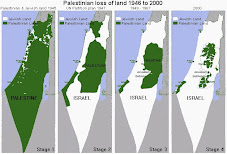IRIN -
 Photo: Phoebe Greenwood/IRIN  |
| Shepherd Abdul Rahim Bsharat, 59, holds his two youngest daughters, Samoud, three (blonde) and Assia, five |
The boulders arrived about six months ago, and are positioned at the entrance to Palestinian villages, indicating that chunks of the Jordan Valley have become a closed military zone claimed by the Israeli army. They signal a further squeeze on the Bedouin communities here.
Shepherd Abdul Rahim Bsharat, 59, and his family have lived and farmed in al-Hadidiya since the 1960s. At that time, he said, there were 400-500 families there. Now, there are 17, who stay on despite having no access to water or electricity. Every building in the village has an Israeli demolition order on it.
On 21 June, the Israeli military gave Bsharat notice that his house and animal shelters could be destroyed at any time. When Bsharat’s house was previously demolished in 2002, his water tank was confiscated too. “If they destroy my property again, I’ll come back and rebuild it again. This is my land,” he told IRIN.
Bsharat’s home is a canopy of sewn-together sacks propped up over bare ground. It can easily be rebuilt. His other problems are more difficult to solve.
 Photo: Phoebe Greenwood/IRIN  |
| Bsharat in front of his home, which has an Israeli demolition order against it |
A report published recently by Save the Children UK entitled Life on the Edge, warns that many parts of Area C have plummeted into a humanitarian crisis more acute than in Gaza.
Al-Hadidiya is surrounded by three expanding Israeli townships, Ro’i, Beka’ot and Hemdat. Its land is directly adjacent to Ro’i and the community collects any over-flow from the water pumps irrigating the settlers’ crops in rusting tins.
Despite a lengthy petition from Bsharat, Israeli authorities have not permitted al-Hadidiya to be connected to the main water network. There is no health centre and no permit to build one. The nearest hospital is several hours away in Jericho.
Israeli roadblocks and checkpoints mean that reaching a doctor can take hours. In 2002, Bsharat’s then two-and-a-half-year-old son was hospitalized for 16 days when a common cold turned into pneumonia. In the same year, his eight-year-old son was badly injured falling off a tractor. It was six hours before a car could get through to al-Hadidiya to get him to hospital. He died from blood loss.
Israel has suffered deadly suicide bombings launched from the West Bank in the past and says strict rules on Palestinian movement enforced through checkpoints and roadblocks are necessary for its security. [The suicide bombings occurred after Israeli forces had invaded, confiscated more Palestinian land, and killed numerous Palestinians.]
According to the Israeli military, homes in al-Hadidiya and much of the Jordan Valley are being demolished because they have either been built illegally, without an Israeli building permit, or are located in “closed military areas”. [in reality, according to the Hague Geneva Conventions, internationally agreed upon, it is the Israeli occupation is illegal.] Around 18 percent of the West Bank is now a closed military zone.
 Photo: Phoebe Greenwood/IRIN  |
| Bedouin children wander away from their home in al-Hadidiya village, which is now within a closed military zone claimed by the Israeli army |
Save the Children works with local NGO Union of Agricultural Work Committees (UAWC) to help families in al-Hadidiya repair damaged buildings and farmland, when possible. But the strict restrictions on building and access mean that the Palestinian Authority and aid agencies are limited in the help they can offer families anywhere in Area C.
“In recent weeks the international community has rightly focused on the suffering of families in Gaza but the plight of children in Area C must not be overlooked. Many families, particularly in Bedouin and herder communities, suffer significantly higher levels of malnutrition and poverty,” Salam Kanaan, Save the Children UK’s country director, said.
“It’s now urgent that steps are taken to ensure children here have safe homes and proper classrooms, enough food to eat and clean water to drink.”







